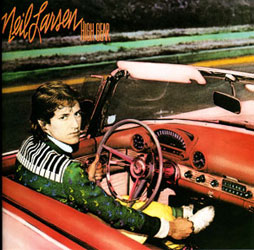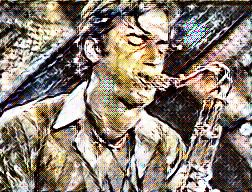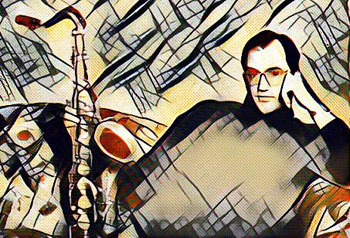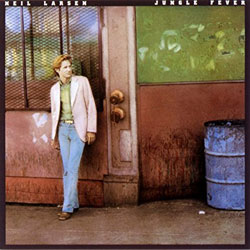

|
Solo Soundclip:
|
| See Steve's Hand-Written Solo transcription |
|
Michael Brecker's
solo on:  As a guest artist/sideman on "JUNGLE FEVER," the great Michael Brecker appeared on a few tracks, and contributed solos to tunes: "Emerald City" and "Last Tango in Paris." One year later, when it came time to record, "HIGH GEAR," Michael was on board again, and was the featured soloist on a couple more tunes. One of my personal favorite solos by Mike was on Neil's composition, "Nile Crescent" which we are going to feature here. As a guest artist/sideman on "JUNGLE FEVER," the great Michael Brecker appeared on a few tracks, and contributed solos to tunes: "Emerald City" and "Last Tango in Paris." One year later, when it came time to record, "HIGH GEAR," Michael was on board again, and was the featured soloist on a couple more tunes. One of my personal favorite solos by Mike was on Neil's composition, "Nile Crescent" which we are going to feature here.Filling out the rhythm section for "HIGH GEAR" was: Abraham Laboriel(El. Bass); Steve Gadd(Drums); Paulinho Da Costa(Perc.), and added for the melodies, the beautiful flute of Joe Farrell. Though I could be completely wrong about this, it's my sense that both Farrell and Brecker were probably overdubbed. At the very least, it would have been a bit strange to have had them both present at the rhythm date, especially as they are both New Yorkers and the album was recorded and mixed in Los Angeles by the none other than Al Schmitt. As it turns, just a few days before this analysis was officially posted at KORNER 1, I reconnected with Buzz Feiten via e-mail, and he confirmed for me that Mike's solo was, in fact, overdubbed. Buzz and I worked together a lot during the mid-'70s, and it was an honor and a thrill to have played alongside him, as he has been a most inspirational player for me, and for countless others. One other oddity about Michael's solo section is that it is 22 bars in length. That's a rather strange number. 24 bars would have made much more sense, at the very least for the sake symmetry. Normally, all of our Western music falls into 4 and 8-bar phrases, and 22 bars is in a bit of a netherworld, though it does conform to 2-bar phrases. Most of the time, if there are going to be overdubbed solos, one is counting on the drummer to use his imagination and to "hear" an imaginary solo in his mind and then react as if it had been really happening live. You can hear during the Brecker solo that Gadd plays some forceful figures as if he was interacting with a soloist. If everything stays on one level, dynamics, etc., it will never give the impression that it had all happened at once. As always, this transcription is written in concert key, but transposed an octave up from where it sounds, as this is where one writes for the guitar. The tenor sax is actually written for one octave plus a whole-step above where it sounds. So, what you might be looking at is actually close in written register to what a tenor saxophonist actually sees. Here's hoping that this is not too confusing for those non-guitarists out there who are visiting these pages for the first time. At the top of the Mike's solo, which follows a synth solo by Neil Larsen, using one of his signature sounds, there is a brief reprise of Neil's [A] melody section where you hear Joe Farrell's flute. I have placed this little 4-bar section at the top of the transcription page so that you can see what's going on. Over an E-pedal from the bass, you see that there are no accidentals, which should signal to you that everything is being played on the white keys of the piano. I would describe "Nile Crescent" as being an E Phrygian [E, F, G, A, B, C, D] tune. For improvising purposes, as I like to think of everything in Dorian minor, I tend to see this as Dm9/E and so, if you play, thinking in D Dorian [D, E, F, G, A, B, C]. the results should be the same, allowing for line configuration differences. If you were to examine the more traditional E Dorian approach to soloing on minor tunes, That mode has both F# and C#. So when those notes become F-natural and C-natural, the mode turns to Phrygian.  It also has to be noted that the entire piece is played in a half-time R&B/Funk groove by the brilliant Steve Gadd. The slow tempo created nightmares for my transcription as I had to improvise after the first 8 bars and the staves are woefully inconsistent which is not my style. But, when someone can play the volume of notes that Michael Brecker could play, what can you do? It also has to be noted that the entire piece is played in a half-time R&B/Funk groove by the brilliant Steve Gadd. The slow tempo created nightmares for my transcription as I had to improvise after the first 8 bars and the staves are woefully inconsistent which is not my style. But, when someone can play the volume of notes that Michael Brecker could play, what can you do?The first 10 bars of Mike's solo are memorable for a couple of reasons. [1] the solo begins with an extreme sense of lyricism, simplicity and romance, not to mention, thematic development. You can really feel the sense of romance on his beautifully emphasized high notes. In keeping with the Phrygian theme of the piece, you hear and see lots of C-naturals, but it is interesting to note that he doesn't actually play an F-natural until the beat 4 of bar 7. And it is fascinating to note that F-natural almost never returns in the solo again. Point [2] is Mike's usage of bent notes! During these years, and Michael and I spent most of the '70s playing in bands together, he was fascinated by the guitar, the blues guitar, and how he could approximate the bent notes and blues mannerisms, à la Albert King. We spent a lot of quiet time together speaking about these things, and I always shared with him whatever I could. In the end, he made it all sound better than I ever could! The bent notes appear in bars 5-7. It is interesting to note that a G#, the major 3rd, can sound so beautiful over E Phrygian! HOW is that possible? Again, I would return to something that Michael has always said about himself, and that is that, he is more of an intuitive player rather than a schooled player. Of course, I don't know that I want to totally believe that, even if he said it repeatedly himself. Also, both Mike and Randy have always enjoyed toying with the major/minor 3rd sounds over minor chords, and they both make it sound completely natural. In this case, you could view that G# as more of a lower neighbor to A-natural, which is the fundamental note of emphasis. From the end of bar 8, Mike vaults up to a super high A-natural. Again, relative to guitar techniques, you could view the G-natural attacked just before it as a hammer-on. This is where another key element in his playing begins to show itself, that element is that Mike never forgets his love for the blues, and in bar 9, it seems that the blues meets late period Coltrane. This is where you begin to hear more outside elements within the lines. From the end of bar 9 into bar 10, I suppose that one could interpret those notes: Eb-Bb-Eb-G-A as a touch of Eb Lydian [Eb, F, G, A, Bb, C, D] crossing into the territory of E Phrygian. But, more than any of this possible theoretical nonsense is the raw emotion with which Mike plays those notes. It is about one's commitment to what one plays, the commitment to what one hears!!! This is what can make anything believable! On the transcription, you will notice the indication to lay back when playing this passage, because notating the precise rhythms is a bit difficult, and one could interpret it in a few different ways. So allow yourself to feel that you might have written it out in a different fashion. The fast passages from bar 11-13 are enough to make me want to quit transcribing!!! But, being the stubborn bastard that I am, I would not let them completely defeat me, even if they might not be 100% accurate. For help in this area, I have no shame about turning to Andy Robinson's brilliant program, Transcribe!" which Michael Brecker told me about years and years ago. Though I am not a saxophonist, the key to these "sheets of sound" that Mike creates are the doubled B-naturals, where one is played as it normally would be, and the 2nd is created by an alternate fingering (+). But even with all of that, the emotional emphasis seems to be placed on the notes A and C-natural. With all the chromaticism at the end of bar 12, once again, it does seem that he is touching upon an area that feels like Eb Lydian. In the final flurry of notes on beat 3 in bar 13, on the first half of that beat, you see: A-F-E-D, which are important notes to D Dorian.  Again, I remind you that this is only the 2nd time that we have heard an F-natural during the solo. It comes as part of a long descending run that finishes on one of Mike's wonderful sounding low A-naturals. Again, I remind you that this is only the 2nd time that we have heard an F-natural during the solo. It comes as part of a long descending run that finishes on one of Mike's wonderful sounding low A-naturals.As we arrive at bar 14, Mike changes up the rhythmic groupings and plays a beautiful passage in groups of 6, and, again, you can see by the absence of all accidentals, that this line is derived from D Dorian modal configurations and that means the presence of several more F-naturals. So, this is one of the moments when the true nature of E Phrygian is right out front. It is one of the great moments of lyricism within this fantastic solo. As bar 15 moves into bar 16, to write this all out in a reasonably decent manner, I knew that I was going to have to go to an 8va indication, because the ledger lines involved in Mike's upper register just become too much to see easily. Here the lines clearly reflect a sense of E minor pentatonic [E, G, A, B, D], but as this is so closely connected to the blues scale, you can hear his usage of this as well by the insertion of the blue note Bb. All of this is leading to his highest note touched upon during the solo which is a high B-natural in bar 17, at the end of beat 3. This passage is one of the bluesiest moments in the solo. On beat 4 of bar 19, Mike begins the final blurry flurry of notes as he heads towards the conclusion of the solo. Once again, he seems to be close to our E Phrygian center as he begins to descend with lots of chromaticism and in bar 20 I hear him passing through that same Eb Lydian area. But beginning on beat 3 of that same bar, he seems to have arrived at D Dorian once again, although there is a C# (a lower neighbor) that he hits. There are yet again, no accidentals as he vaults up to his high A-natural. After the emotion of that note, he descends with bluesy phrases on beats 3 and 4 before concluding the solo in bar 22 with more E pentatonic lines with the blue note Bb (b5) added in for good measure. The solo ends on the root, an E-natural. This was truly a remarkable journey of creativity and emotion, and all within just 22 bars. As I was preparing this presentation, as I often do, I did some research and was saddened to find that these two wonderful albums by Neil Larsen were actually really hard to find. For example, at Amazon.com, and even iTunes, I didn't see mp3 versions readily available for each album. I found this really hard to believe, because my perception was that these albums were quite popular during their time.  So, perhaps a little push from this piece might inspire the executives in charge to do something, and simply make these albums easily available to the public. If I may, here is a bit of information about the first album, "JUNGLE FEVER," which was recorded in 1978 with personnel that featured: Buzz Feiten(Guitar); Willie Weeks(El. Bass); Andy Newmark(Drums); Ralph MacDonald(Perc.); Michael Brecker(Tenor Sax); and Larry Williams(Alto Sax & Alto Flute) & Jerry Hey(Trumpet). Once again, engineered and mixed by Al Schmitt, there is great continuity in the recorded sound and audio presentation. So, perhaps a little push from this piece might inspire the executives in charge to do something, and simply make these albums easily available to the public. If I may, here is a bit of information about the first album, "JUNGLE FEVER," which was recorded in 1978 with personnel that featured: Buzz Feiten(Guitar); Willie Weeks(El. Bass); Andy Newmark(Drums); Ralph MacDonald(Perc.); Michael Brecker(Tenor Sax); and Larry Williams(Alto Sax & Alto Flute) & Jerry Hey(Trumpet). Once again, engineered and mixed by Al Schmitt, there is great continuity in the recorded sound and audio presentation.If you are new to all of this, and almost 40 years have passed as I sit here writing this, you would do well to investigate the past work that Neil Larsen and Buzz Feiten have done together. Though these albums might also be hard to locate, make the effort, because you never know what you might come-up with. Look no further than their album as "FULL MOON" from 1971. And then, the "LARSEN-FEITEN BAND" from 1980. As a guitarist, I can say with great confidence that some of Buzz' guitar solos contained on "FULL MOON" are just breathtakingly spectacular. You won't regret finding them. The solo on "The Heavy Scuffles On" is an absolute killer!!! It's a bit hard to believe, but this past January, 2017 marked the 10 year anniversary of the passing of Michael Brecker. I don't know what happened to the time. I often find myself getting upset when I can see that Jazz radio does not play Michael's recordings nearly enough. I just can't understand that. No matter what goes on, it is important to recognize the work of this great artist, and remind everyone that he must never be taken for granted. For those of us who were lucky enough to have known him as a friend, a bandmate, and colleague, he is missed every single day as he inspired us to go forward. My thoughts are always with his family, so to Randy, Emily, Susan, Jess, Sam, and Amanda, this little musical salute is dedicated to you.
[Photos: Michael Brecker with Style® Jagged Treatment
Michael Brecker with Style® Kandinsky Treatment] |